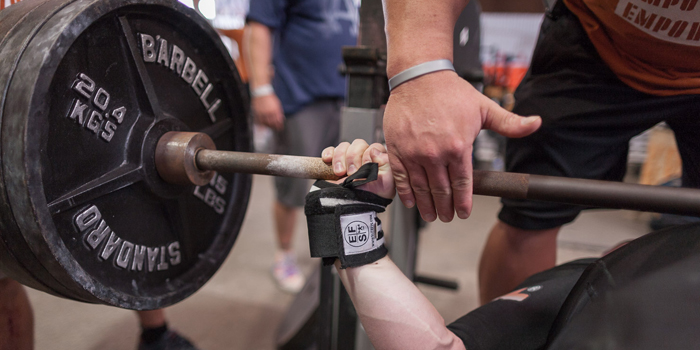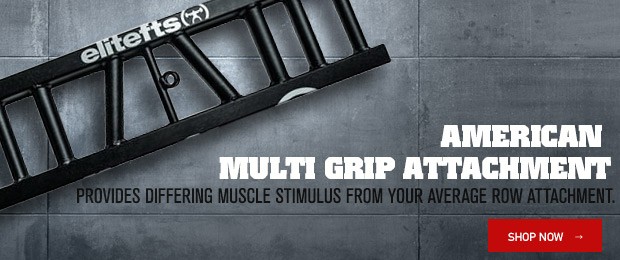
elitefts Classic
Several years ago, in order to fully immerse myself into powerlifting, I changed my eating habits (from semi-shitty to all-out crappy), bought a truckload of Chuck Taylor’s (a fashion no-no, even for someone with such a laissez-faire attitude towards fashion as I), and began my quest to become one of the most physically unappealing males worldwide. It was a fun but difficult road. As John Stafford once said, “We work so hard to be so ugly.” Anyway, on the road to immersion I, like many of you have done, printed out Louie’s articles and engrossed myself in them. I had copies of his articles in my backpack, in my bathroom and next to my bed. I should point out that I was in college at the time, hence the backpack. After re-reading Lou’s article about 1000’s times, one of the things that I noticed was how important the upper back is for bench pressing. I was never a big bench presser, so when this knowledge was bestowed upon me, I was a little taken aback. Isn’t the bench all pecs, shoulders, and triceps?
From all the years of deadlifting and doing Olympic movements, I had accumulated an impressive set of traps. I thought that this is all I needed to do to build the upper back for pressing. I eventually found out that this is not the case. Many of the movements below, unlike the deadlift and Olympic lifts are done so that the end position mimics the feel of how your upper back is when you bench press.
So why do you want to build a strong, thick upper back? There are a couple of reasons:
- Stability – I define this as being able to take a maximum weight off and NOT get flattened. You need to be strong and thick enough to maintain a good arch in your upper back to maintain the correct pressing position. If you take the weight off and immediately flatten out, you are in for a long day.
- Structural Integrity – Since the majority of us have done much more pressing than pulling and have a huge imbalance, making the upper back a priority will hopefully lead to fewer injuries.
I have classified upper back exercises into two categories; direct and indirect. I only do this to make things a little bit easier. Now the direct exercises, while not isolation exercises are more directed towards the upper back. The indirect exercises target the lats and the upper back. There are two laws that I adhere to when training with these two kinds of movements:
- With direct upper back exercises, volume is king.
- Train your indirect upper back exercises heavy.
So what do I mean by high volume? This is open to interpretation, but for me, it’s generally 4-5 sets of 10-20 reps. I like to perform 1-2 exercises from each category a week. For the heavier movements, 3-5 sets of 5-10 reps seem to work well.
Direct Upper Back Exercises
Face Pulls — This is one of the most popular upper back exercises. It works well and is easy to do. The face pull can be done with just about any kind of rope, triceps strap, straight bar…it really doesn’t matter. Just pull something to your face.
Seated DB Cleans — Next to the JM Press, this exercise is probably the most asked about. This has replaced the long lost (and let’s keep it that way, people) Paul Dicks Press in the category of, “Most likely to interpret wrong” category. The word “clean” does not make this movement an Olympic or explosive movement. Think about doing an external rotation but starting the movement with arms straight and down to the sides. This is usually done as one fluid motion, not broken up into stages. If you want to see it in action, get the EFS Exercise Index for the Bench Press DVD.
Rear Laterals — This is simple enough. You can do these with dumbbells, holding on to plates or by using a cable machine. I like to use two different hand positions: thumbs pointed towards the front (this is what is most commonly used) and thumbs pointed at each other. The latter is a little bit harder. Which one is better? Neither, they are just different. This is a good way of adding some variety in a fairly dull movement.
Standing Cable Cleans — This is exactly like the seated DB clean, only that you use a cable and a single D attachment. Start by holding the handle, performing an upright row, and finishing in an external rotation.
Band Pullaparts — Another very simple movement done with the aid of bands. Usually, a mini or light band is used. Give it a tug and hold it for a few seconds. You can move your grip in/out for more/less tension. You can also pull from various angles; you can raise or lower your arms for a different feel. I like to keep my arms straight throughout the entire movement. I also think this movement will help you realize how tight your upper back needs to be during a squat or bench press.
Rear Delt Machine — This one is pretty easy because it’s a machine. This makes it fairly hard to screw up.
High DB Rows — These are best done while lying on a bench. This is very similar to a chest supported row, but you simply pull the dumbbells to a higher position. Lie down on an incline bench, grab two dumbbells and with your elbows out, pull the dumbbells to your face or slightly lower.
Muscle Snatch — I think this is a great exercise and I should probably do it more often, but somehow, the ease of the face pull always beckons to me. To do this exercise, grab the bar with a wide grip. What’s wide? To start with, try putting your index fingers on the rings of the power bar. You can go narrower or wider as you see fit. With no leg drive, begin by doing an upright row. Make sure you keep your elbows higher than the bar. Once the bar reaches (approximately) your chin, being rotating your shoulders until the bar is overhead with your arms locked out. Your final position should be the same as a snatch: arms overhead and fully locked out. This does not (and really cannot) be done with heavy weights.
Indirect Upper Back Exercises
Chest Supported Rows — This is one of the best lat and upper back exercises you can do. Plus, there is little lower back stress.
DB Rows — Just pick up any bodybuilding magazine for pics of this exercise. You can do these with several different hand/elbow positions. For example, you can have your elbow tucked or straight out to the side. You can bring the dumbbell high to your upper pec area, or you can tuck your elbow and bring it lower. The farther your elbow is out (generally) the less weight that you will do. What you can do is do a few lighter sets with your elbow out and as the weight becomes heavier, tuck it in.
Bent Over Rows — This is a staple of any lat/upper back workout. This exercise has been described to death, so I don’t think there is much need for me to do it. Like the dumbbell row, you can vary where you pull the bar; high up on the chest (elbows out) or brought low to your stomach (elbows tucked).
Pull-ups/ Chin-ups — This exercise is a favorite of mine and one of the best overall upper body exercises one can do. Even if you cannot do 8-10 reps, multiple sets of low reps (2-4) work very well. When I first began doing these, I would perform 6 sets, all with different grips. Each set consisted of 3 reps with about 30 seconds rest between sets. I would do this two times through with about 2-3 minutes rest between groups. The 6 grips that I did were:
- Wide grip pronated
- Medium grip pronated
- Narrow grip pronated
- Narrow grip supinated
- Medium grip supinated
- Neutral grip (palms facing)
I hope that this article introduced you to some new movements or reinforced the idea of how important the upper back is to your training. If anyone has any more great exercises for the upper back, please let us know. I’m always looking for some variety.









